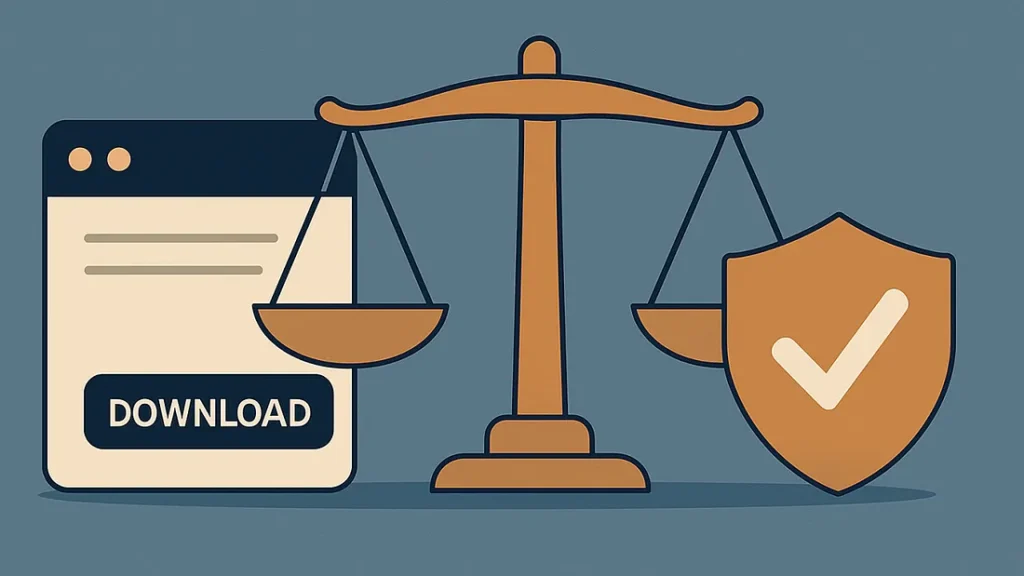
Dark Patterns Uncovered (Part 2): Ethics, Transparency, and User Trust
“When profit is at stake, content and interaction designers put ethics aside all too often. It’s time to say: enough.”
We’ve all encountered them — some of us without even realising it.
Dark patterns have long lurked within the digital spaces we navigate daily.
In Part 1, we traced their origins, the psychological levers that make them effective, and the most common types of dark patterns.
Today, we turn a sharper lens on the ethical stakes behind deceptive design, the wave of global regulations rising to counter it, and inspiring examples of transparent, trust-building UX done right.
📌What’s Inside (Part 2)
- The Ethical Imperative
- Regulations: Dark Patterns in the Crosshairs
- Why Ethical Design is Also Smart Business
- How to Push Back in the Corporate Environment Without Losing Business
- Positive Examples: Ethical UX in Action
- Designers, It Starts with Us
⚖️The Ethical Imperative
For UX practitioners, dark patterns pose a profound ethical challenge:
Whose interests do our designs truly serve?
Ethical UX demands that we prioritise the user’s informed choices and wellbeing, even when this stance may clash with short-term business targets.
Dark patterns invert this principle, favouring immediate gains in conversions, sign-ups, or data collection at the expense of honesty and respect.
While dark patterns might deliver short-term wins, they carry an immense hidden cost: the erosion of user trust and enduring reputational damage.
Today, this is no longer merely an ethical debate, it’s a business-critical and legal risk.
⚖️Regulations: Dark Patterns in the Crosshairs
Governments and regulators around the world are now moving decisively against deceptive design:
- United States: In 2023, the Federal Trade Commission (FTC) sued Amazon, alleging that it had “tricked and trapped” users into Prime subscriptions and made cancellations unnecessarily difficult.
The FTC’s Chair, Lina Khan, stated: “Firms must design their interfaces so that users are not manipulated into making choices that aren’t in their interest.”
Following a sweeping 2024 global review, the FTC found dark patterns on 76% of subscription-based websites.
The agency has signalled an escalation of enforcement actions against companies exploiting manipulative design.
- European Union: The EU’s Omnibus Directive and Digital Services Act have taken direct aim at manipulative design.
In 2022, pressure from the European Commission forced Amazon to reduce its Prime cancellation process to a transparent two-click flow.
EU Justice Commissioner Didier Reynders was unequivocal: “Our screening shows that nearly 40% of the online shopping websites rely on manipulative practices to exploit consumers’ vulnerabilities or trick them. This behavior is clearly wrong and against consumer protection.”
GDPR complements this stance by outlawing deceptive consent mechanisms, such as hidden opt-outs and pre-ticked boxes.
- United Kingdom: The Competition and Markets Authority (CMA) has issued stern warnings against “privacy zuckering” — practices that mislead users into sharing personal data.
The CMA is actively investigating e-commerce and subscription services that pressure or mislead consumers.
In its guidance, it stresses that businesses must avoid designs that “coerce, manipulate or deceive consumers into making decisions.”
💰Why Ethical Design is Also Smart Business
Beyond legal compliance, there is a growing commercial incentive for transparent, user-first design.
A 2023 Edelman Trust Barometer report found that 67% of consumers say trust in a brand is a deciding factor in their buying decisions, often outweighing price or convenience.
In a marketplace where users are increasingly sceptical, dark patterns no longer fly under the radar; they trigger backlash, brand damage, and high churn rates.
Conversely, ethical UX can become a powerful differentiator.
Many brands like Mozilla, Proton, and Hey email have built loyalty by championing privacy, transparency, and “no dark patterns” pledges.
“If you have to trick users into doing something, it’s because they didn’t want to do it. Focus instead on making them want to do it.” (Jared Spool)
🙅How to Push Back in the Corporate Environment Without Losing Business
Advocating for ethical UX can feel daunting, particularly when immediate KPIs or revenue pressures dominate discussions.
However, ethical pushback doesn’t have to be adversarial.
Here’s how to go about it:
1️⃣ Speak the Language of Business Outcomes
Instead of framing your pushback as a “moral objection,” tie it to business risk and value. Highlight how dark patterns can lead to:
- Increased churn rates (users feeling deceived leave faster)
- Regulatory fines (which can be steep and highly public)
- PR disasters (which erode trust and cost far more to repair than to prevent)
- Decreased customer lifetime value (trust impacts loyalty)
When you position ethical design as risk management and brand-building, you’re speaking in terms executives prioritise.
Example:
“Implementing this dark pattern might temporarily boost sign-ups, but research shows dark UX correlates with a 38% increase in cancellations within six months.
If we want sustainable growth, we should invest in trust-based design instead.”
2️⃣ Bring Evidence
Arm yourself with concrete case studies and research.
Show how companies like Apple, Monzo, or Patagonia have reaped the rewards of user trust.
Cite sources such as the FTC warnings, CMA guidelines, GDPR cases, and studies from groups like the UX Collective or the Nielsen Norman Group.
3️⃣ Offer Ethical Alternatives
Don’t just say “no”, but propose better solutions.
Show how you can still achieve business goals with user-respecting tactics.
For instance:
Instead of a hidden cancellation link, propose a clear cancellation flow, but use a friendly, compelling value reminder before the final step.
Instead of a guilt-tripping “confirmshame” button, suggest a positive reinforcement message that keeps doors open for future engagement.
4️⃣ Frame Pushback as Protecting the Brand
Remind stakeholders that trust is a fragile commodity.
One viral TikTok or news article exposing a deceptive UX flow can undo years of brand-building.
In a digital-first world, brand damage spreads faster than ever.
5️⃣ Escalate Carefully (Only When Necessary)
Internal escalation should always be a last resort, but protecting both your users and your career sometimes demands it.
Many companies now have formal ethics committees or escalation channels precisely for these issues.
When you handle pushback thoughtfully, you position yourself not as a “difficult designer” but rather as a strategic advisor safeguarding both user trust and business sustainability.
✔️Positive Examples: Ethical UX in Action
While dark patterns have dominated headlines, some major brands are proving that transparency and respect can be powerful competitive tools. ⬇️
✅Apple
Apple has long promoted itself as a champion of user privacy, with slogans like “Privacy. That’s iPhone.”
Their App Tracking Transparency feature (introduced in iOS 14.5) forces apps to request explicit permission before tracking user behaviour. Instead of burying this choice, Apple places it prominently, empowering users to make an informed decision.
This approach has not only built trust but positioned Apple as a leader in the privacy-first movement.

✅ Monzo
British digital bank Monzo prides itself on radical transparency.
Its user interfaces are clear and jargon-free.
When users set up an overdraft, for example, Monzo plainly shows the costs involved and allows easy cancellation.
Their “no hidden fees” policy is part of their brand identity, helping Monzo grow rapidly through customer trust and word-of-mouth.
✅ The Guardian
Unlike many media outlets that nudge users into subscriptions with dark UX, The Guardian asks for voluntary contributions through clear, respectful messaging.
Their request frames support as a positive action, not a guilt trip, and they avoid locking content behind aggressive paywalls.
This ethical approach has built loyalty among millions of readers worldwide.

✅ Patagonia
The Outdoor clothing brand Patagonia is transparent about everything from environmental impact to supply chain issues.
Their “Don’t Buy This Jacket” campaign famously encouraged users to reconsider consumption.
Rather than manipulating users into impulse purchases, they fostered deeper brand loyalty through honesty, contributing to a major increase in sales over the long term.

Each of these companies has demonstrated that respecting users is not just an ethical choice, but it is also a commercially successful one.
They treat trust as a key brand asset, not an afterthought.
“…trust has become the most valuable currency. It’s the foundation of every meaningful online transaction, from buying products to joining communities, seeking advice, or following a mentor. Yet, building and maintaining trust online has never been more challenging.”
Designers, It Starts with Us
Have you ever deployed a dark pattern?
Maybe a manipulative decline message like “No thanks, I like wasting money”? A deceptive pre-selected box? Growth hacks without full consent?
Acknowledging these moments is not about guilt but about growth.
Ethical UX is not always a clear-cut line, there’s a nuanced distinction between persuasive design and manipulative design.
The test lies in intent and user benefit.
As UX expert Aarron Walter advises: “Design for trust. If you don’t, you may win the short-term conversion but lose the long-term customer.”
Ask yourself:
- Would I feel good explaining this design to a user face-to-face?
- Am I guiding or tricking?
- Am I prioritising short-term metrics over long-term trust?
The tide is shifting.
Legislation is strengthening.
Users are savvier.
The market is rewarding brands that put transparency at the heart of their experience.
Designers must lead this evolution, not just because it is legally necessary, but because it aligns with the original spirit of UX: helping users achieve their goals with clarity, ease, and dignity.
As Joe Sparano famously said, ““Good design is obvious, great design is transparent””.
It’s time to ensure our designs speak clearly and honourably.
This space thrives because of YOU. ❤️
If the resources I share help you grow, a small contribution from you could keep this community strong.
Every bit helps, and by supporting me, you’re directly helping keep this space alive and growing.❤️⬇️
Or simply scan this QR code ⬇️

Your support means a lot!
You might also like:
📚 Sources & Further Reading
- Deceive, confuse, wear down: the dark patterns of UX by Piotr Ślusarski (Medium).
- Quote commonly attributed to Lina Khan, Chair of the U.S. Federal Trade Commission (FTC).
- Consumer protection: manipulative online practices found on 148 out of 399 online shops screened.
- 2023 Edelman Trust Barometer.
- Quote commonly attributed to Jared Spool (UX communities, talks, blogs, and social media posts).
- Avoiding Dark Patterns in Web Design.
- ‘Privacy. That’s iPhone’ ad campaign launches, highlights Apple’s stance on user protection (image source).
- The Guardian website (screenshot)
- Patagonia (image source)
- Trust: The Currency of the Online World.
- Quote commonly attributed to Aarron Walter, a renowned UX designer and author of “Designing for Emotion”.
- Quote commonly attributed to Joe Sparano.
Share this article:
